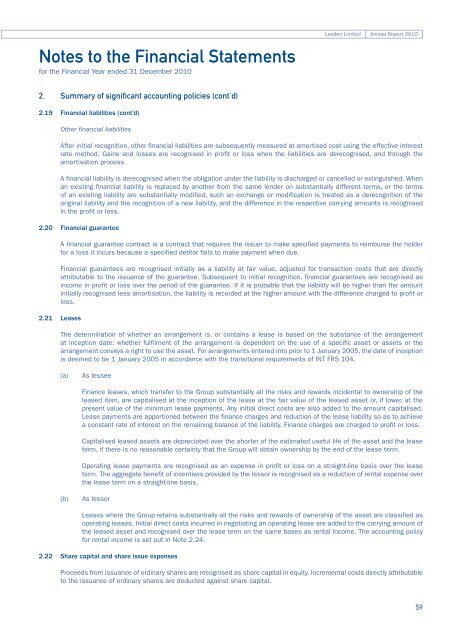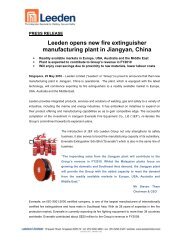Annual Report 2010 - Leeden Limited
Annual Report 2010 - Leeden Limited
Annual Report 2010 - Leeden Limited
You also want an ePaper? Increase the reach of your titles
YUMPU automatically turns print PDFs into web optimized ePapers that Google loves.
Notes to the Financial Statementsfor the Financial Year ended 31 December <strong>2010</strong><strong>Leeden</strong> <strong>Limited</strong> <strong>Annual</strong> <strong>Report</strong> <strong>2010</strong>2. Summary of significant accounting policies (cont’d)2.19 Financial liabilities (cont’d)Other financial liabilitiesAfter initial recognition, other financial liabilities are subsequently measured at amortised cost using the effective interestrate method. Gains and losses are recognised in profit or loss when the liabilities are derecognised, and through theamortisation process.A financial liability is derecognised when the obligation under the liability is discharged or cancelled or extinguished. Whenan existing financial liability is replaced by another from the same lender on substantially different terms, or the termsof an existing liability are substantially modified, such an exchange or modification is treated as a derecognition of theoriginal liability and the recognition of a new liability, and the difference in the respective carrying amounts is recognisedin the profit or loss.2.20 Financial guaranteeA financial guarantee contract is a contract that requires the issuer to make specified payments to reimburse the holderfor a loss it incurs because a specified debtor fails to make payment when due.Financial guarantees are recognised initially as a liability at fair value, adjusted for transaction costs that are directlyattributable to the issuance of the guarantee. Subsequent to initial recognition, financial guarantees are recognised asincome in profit or loss over the period of the guarantee. If it is probable that the liability will be higher than the amountinitially recognised less amortisation, the liability is recorded at the higher amount with the difference charged to profit orloss.2.21 LeasesThe determination of whether an arrangement is, or contains a lease is based on the substance of the arrangementat inception date: whether fulfilment of the arrangement is dependent on the use of a specific asset or assets or thearrangement conveys a right to use the asset. For arrangements entered into prior to 1 January 2005, the date of inceptionis deemed to be 1 January 2005 in accordance with the transitional requirements of INT FRS 104.(a)As lesseeFinance leases, which transfer to the Group substantially all the risks and rewards incidental to ownership of theleased item, are capitalised at the inception of the lease at the fair value of the leased asset or, if lower, at thepresent value of the minimum lease payments. Any initial direct costs are also added to the amount capitalised.Lease payments are apportioned between the finance charges and reduction of the lease liability so as to achievea constant rate of interest on the remaining balance of the liability. Finance charges are charged to profit or loss.Capitalised leased assets are depreciated over the shorter of the estimated useful life of the asset and the leaseterm, if there is no reasonable certainty that the Group will obtain ownership by the end of the lease term.Operating lease payments are recognised as an expense in profit or loss on a straight-line basis over the leaseterm. The aggregate benefit of incentives provided by the lessor is recognised as a reduction of rental expense overthe lease term on a straight-line basis.(b)As lessorLeases where the Group retains substantially all the risks and rewards of ownership of the asset are classified asoperating leases. Initial direct costs incurred in negotiating an operating lease are added to the carrying amount ofthe leased asset and recognised over the lease term on the same bases as rental income. The accounting policyfor rental income is set out in Note 2.24.2.22 Share capital and share issue expensesProceeds from issuance of ordinary shares are recognised as share capital in equity. Incremental costs directly attributableto the issuance of ordinary shares are deducted against share capital.59





